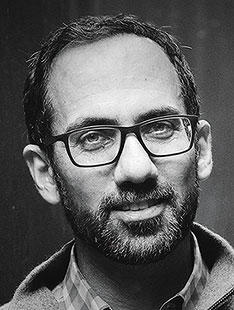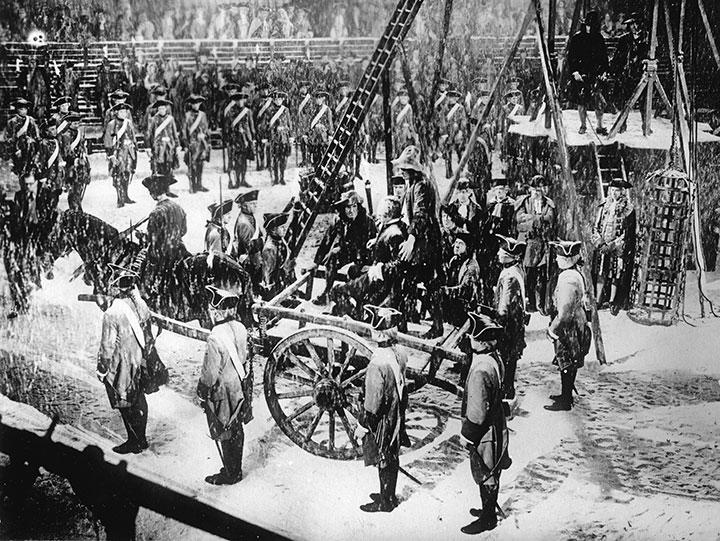Essay: Truth in History

I remember the moment perfectly. I was in Stuttgart, a few days after Christmas 2011. I had spent the previous three days in the central archive in the city center, reading through the records of one of the most notorious trials in German history. The trial took place in 1737–38, and led to the execution of a man named Joseph Süss Oppenheimer, better known to history as “Jew Süss.”
The archival materials I had been studying were both extraordinary and utterly frustrating, and I wasn’t sure how best to proceed. As I was leaving the archive, I lingered for a moment in the vestibule, looking at the large snowflakes slowly descending from the sky and recalling the last few meetings of the undergraduate seminar I had just taught at Princeton. Then, too, snow was lying outside. And all of a sudden it hit me: The problem I was facing was not a problem at all; in fact, it was a solution.
Joseph Süss Oppenheimer is one of the most important figures in the history of anti-Semitism. Born in the Jewish community of Heidelberg in the last decade of the 17th century, he served as the personal banker of several princes in southwest Germany in the 1720s before moving to Stuttgart in 1733 and becoming the “court Jew” (financial and political adviser) of Carl Alexander, the duke of the small German state of Württemberg. For several years after 1733, Oppenheimer was highly successful, serving as the duke’s closest associate while also making large sums of money for himself. But when Carl Alexander died unexpectedly in 1737, the Württemberg authorities arrested Oppenheimer, put him on trial, and condemned him to death for a long list of unsubstantiated accusations, including bribery, treason, and rape. On Feb. 4, 1738, Oppenheimer was hanged just outside Stuttgart, his body then locked for six years in a metal cage at the northern entrance to the city.
Although the legal proceedings against Oppenheimer concluded almost three centuries ago, his trial never quite ended. Ever since Oppenheimer’s execution, his story came to represent the contested topic of Jewish integration into German society. Oppenheimer was neither the first nor the last prominent Jew to rise and fall in a predominantly Christian society, but his story, taking place on the verge of the modern period, became a parable about Jewish fate in the transition to modernity. Particularly since the early 19th century, when questions about Jewish emancipation came to the fore in Germany, the story of this man acquired the status of a literary battleground on which different conceptions about the past, present, and future of German Jews were encoded and contested. Most notorious in this respect is a Nazi propaganda film from 1940, created at the behest of Joseph Goebbels. It is thus no exaggeration to say that “Jew Süss” is to the German collective imagination what Shakespeare’s Shylock is in the English-speaking world. “Jew Süss” is much more than a historical figure; he is a cultural icon.
Now put yourself in my shoes. As a historian of early modern Germany, I had come to Stuttgart to examine the records of Oppenheimer’s trial. What I hadn’t realized was just how extensive the records would be. The state archive in Stuttgart keeps them in more than 100 cardboard boxes in its secure, climate-controlled basement. Containing over 30,000 handwritten pages, these boxes include copies of the interrogation protocols of Oppenheimer and his associates; records of the judges’ deliberations; reports made by Oppenheimer’s defense attorney; and a great number of poems, pamphlets, and essays about Oppenheimer’s final months, days, and even minutes. The archive contains a whole universe of sources about Oppenheimer’s case, an unparalleled opportunity — or at least so it seemed at first glance — to write an extraordinarily detailed history of the case of the notorious “Jew Süss.”
But while the richness of the sources about Oppenheimer’s trial is remarkable, the sources themselves leave much to be desired. This is often the case with events that generate so many written sources. Because Oppenheimer was famous and powerful, and especially because he was very vulnerable after his arrest, few had reason to tell the truth, the whole truth, and nothing but the truth about his life. The judges assigned to his case lacked direct evidence against him, but wishing to make an example of him anyway, they left no fact in its right place in pursuit of their purpose. The testimonies of Oppenheimer’s alleged accomplices, who were trying to save their own skins, are at least as problematic. And last but not least, Joseph Süss Oppenheimer was fighting for his life and can be considered anything but a reliable witness as far as his own deeds and misdeeds are concerned.
Therein lies the predicament I contemplated on that December day in 2011. I had a huge amount of material about Oppenheimer’s trial, but almost all of it was extremely tendentious. How could I, as a historian, write an account of Oppenheimer’s trial based on such sources?
Anyone who had taken history classes in college probably would recognize two ways historians generally deal with such a predicament. The first is similar to the delivery of a course of lectures, where a professor tells students what happened without bothering them with the difficulty of gaining that knowledge. Consider it for a moment: Most professors deliver their lectures from a podium, using notes, and with a grave air of certainty. Very rarely do they allow for any questions or interruptions during their 50-minute monologues and almost never do they utter the words “I don’t know.” In academic jargon, we call this stance “omniscient.”
I would not gloss over the many contradictions in my sources, but rather place them front and center.
The second approach couldn’t be more different. Unlike in lectures, in seminars professors do away with the omniscient stance in favor of the Socratic method, the cornerstone of which is, of course, the dialogue between teacher and students. When led by the right professor, the seminar becomes a space where students’ curiosity and intelligence are front and center, where doubt is encouraged and questions are welcome. In the seminar, truth is reached through a conversation between professor and students and between readers and texts. This is why I feel much more at home in the seminar room than in the lecture hall. I have never seen the point of inundating my students with information or pretending that I know everything. Rather, I try to inspire, to help my students discover important truths through dialogue and different points of view. For me, looking at problems from different angles is at the very core of what I do as a Princeton professor.
Six years ago, as I was looking at the big snowflakes parachuting from the Stuttgart sky, it suddenly dawned on me what kind of book I wanted to write about Joseph Süss Oppenheimer. Rather than a lecture-like book in which I pretend to know everything about his case, my book would be a polyvocal, seminar-like work of scholarship. In it, I would not gloss over the many contradictions in my sources, but rather place them front and center in my narrative. If I knew something, I would say so, but if I didn’t know something, I would say so too. In a nutshell: I would replicate on paper what I have always striven to do in class.
Six years later, Princeton University Press has just published that book. It’s called The Many Deaths of Jew Süss: The Notorious Trial and Execution of an Eighteenth-Century Court Jew. The book draws on the rich archival material I found in Stuttgart to tell not one, but four conflicting versions of Oppenheimer’s life and death as told by contemporaries: the leading inquisitor in the criminal investigation; the most important eyewitness to Oppenheimer’s final days; a fellow court Jew who was permitted to visit Oppenheimer on the eve of his execution; and Oppenheimer’s earliest biographer. All four narratives are based on archival evidence, but they often contradict one another and sometimes even contradict themselves. One early reader of the book compared it to Japanese director Akira Kurosawa’s famous movie Rashomon, while another saw similarities with William Faulkner’s As I Lay Dying.
What emerges from this storytelling technique is a lurid tale about “Jew Süss” that involves greed, sex, violence, and lies, but also a great deal that is moving and indeed true. Life, after all, is full of tensions and contradictions, so highlighting them in a history book makes it more, not less, truthful. In its polyphonic, multi-perspectival treatment of the notorious case of “Jew Süss,” in its refusal to reduce this story to one thread only, and in the many moments of doubt and uncertainty it evokes, the book illustrates yet again what Plato said about conflicting arguments: that they are the stuff from which both thinking and life are made. In that respect, all thoughtful writing, like all meaningful teaching, is polyphonic in nature.












2 Responses
Norman Ravitch *62
8 Years AgoWould any of you join me in...
Would any of you join me in thinking that the words of Pontius Pilate, often ridiculed out of religious bias, might in fact be words of wisdom: WHAT IS TRUTH?
Norman Ravitch *62
8 Years AgoOf course professional...
Of course professional historians know that history is not just what happened but how it has been treated over time and what lessons can or cannot be derived from events. The public does not know this and perhaps never will. Non-professional readers of history seek answers from history to important questions but rarely are they inclined to accept the radical subjectivity of our attempts to understand the past. This could call into question -- for some it has -- the value of studying history. The old saying, those who know no history are bound to repeat it, is not true. One can repeat many errors because one cannot know all the ramifications of an event, a decision, a motive, or a likely outcome.
I think the value of studying history is not to find answers but to understand better and more intimately the problems of understanding anything, anyone, any problem. We hardly understand one another -- that is, what people are really motivated by when they make decisions, trivial and important alike. Do I really understand why you disagree with me about taxes, Trump, war, or peace? Can I really get behind the mask you wear to conceal your real person and to mislead others into thinking better of you than you deserve? History teaches the weakness of our efforts. That does not mean we need to abandon our efforts. There is still a difference between propaganda and fact. But a recognition of our weaknesses cannot ever be bad. Humility is not just a theological virtue, it is a human requirement for justice.